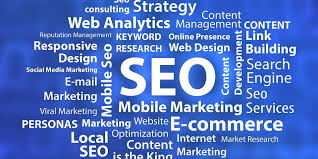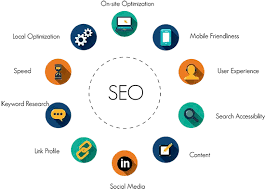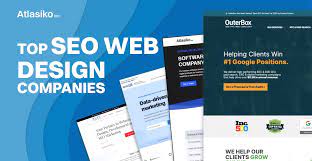The Power of Search Engine Marketing
Search Engine Marketing (SEM) is a powerful digital marketing strategy that aims to increase a website’s visibility in search engine results pages through paid advertising. It encompasses both Search Engine Optimization (SEO) and Pay-Per-Click (PPC) advertising, offering businesses a comprehensive approach to reaching their target audience online.
Key Components of SEM:
1. SEO: SEO focuses on improving a website’s organic search ranking by optimising its content, meta tags, and backlinks. By enhancing the site’s relevance and authority, SEO helps attract more organic traffic and improve visibility on search engines like Google.
2. PPC Advertising: PPC advertising involves bidding on keywords relevant to your business to display ads at the top of search engine results pages. Advertisers only pay when users click on their ads, making it a cost-effective way to drive targeted traffic to a website.
The Benefits of SEM:
- Increased Visibility: SEM helps businesses appear prominently in search results, making it easier for potential customers to find them online.
- Targeted Advertising: With SEM, businesses can target specific demographics, locations, and interests to reach their ideal audience effectively.
- Measurable Results: SEM provides detailed analytics and insights into campaign performance, allowing businesses to track ROI and make data-driven decisions.
- Faster Results: Unlike SEO, which takes time to see significant results, PPC campaigns can generate immediate traffic and leads for businesses looking for quick wins.
In Conclusion
In today’s competitive digital landscape, Search Engine Marketing plays a crucial role in helping businesses stand out online. By combining the strengths of SEO and PPC advertising, businesses can drive targeted traffic, increase brand awareness, and achieve measurable results that contribute to their overall success.
Comprehensive Guide: 18 Frequently Asked Questions About Search Engine Marketing
- What are the three types of search engine marketing?
- What is an example of search engine marketing?
- What are the 3 main search engine marketing products?
- What is search engine marketing with example?
- What is search engine marketing examples?
- What are the three search engine marketing products?
- What is SEM vs SEO?
- What is meant by search engine marketing?
- What are the steps for search engine marketing?
- What is SEM with an example?
- What is PPC and SEM marketing?
- Why search engine marketing?
- What is an example of a search engine marketing?
- What are the two types of search engine marketing?
- What is an example of a search engine marketing ad?
- What is the difference between SEO and SEM?
- What are the different types of search engine marketing?
- What is search engine marketing and how it works?
What are the three types of search engine marketing?
Search Engine Marketing (SEM) encompasses three main types of strategies: Search Engine Optimization (SEO), Pay-Per-Click (PPC) advertising, and Local Search Marketing. SEO focuses on improving organic search rankings by optimising website content and structure. PPC advertising involves bidding on keywords to display ads at the top of search results, with advertisers paying when users click on their ads. Local Search Marketing targets local customers by optimising business listings and reviews to appear in location-based searches. Each type of SEM strategy plays a crucial role in helping businesses enhance their online visibility and attract targeted traffic from search engines like Google.
What is an example of search engine marketing?
An example of search engine marketing (SEM) is when a company creates a Google Ads campaign to promote its new line of eco-friendly products. By bidding on relevant keywords related to sustainability and eco-friendly living, the company’s ads appear at the top of Google search results when users search for terms like “environmentally friendly products” or “sustainable lifestyle.” When users click on these ads, they are directed to the company’s website, driving targeted traffic and potential customers to learn more about and purchase the eco-friendly products. This demonstrates how SEM allows businesses to strategically advertise their offerings to a specific audience through paid search engine advertising channels like Google Ads.
What are the 3 main search engine marketing products?
When it comes to Search Engine Marketing (SEM), the three main products that businesses commonly utilise are Search Engine Optimization (SEO), Pay-Per-Click (PPC) advertising, and Local Search Marketing. SEO focuses on improving a website’s organic search ranking through content optimization and backlink building. PPC advertising involves bidding on keywords to display ads at the top of search results, with advertisers paying when users click on their ads. Local Search Marketing targets local audiences by optimising business listings and reviews to enhance visibility in location-based searches. These three SEM products work together to help businesses increase their online visibility, drive targeted traffic, and achieve marketing goals effectively.
What is search engine marketing with example?
Search Engine Marketing (SEM) is a digital marketing strategy that involves promoting a website by increasing its visibility in search engine results pages through paid advertising. An example of SEM is Google Ads, where businesses bid on keywords related to their products or services to have their ads displayed at the top of search results when users search for those keywords. When a user clicks on the ad, the advertiser pays a fee, hence the term Pay-Per-Click (PPC) advertising. SEM allows businesses to target specific audiences, drive relevant traffic to their websites, and achieve measurable results in terms of clicks, conversions, and ROI.
What is search engine marketing examples?
Search engine marketing examples encompass a variety of strategies used to promote businesses online through search engines. Some common examples include Pay-Per-Click (PPC) advertising, where businesses bid on keywords to display ads at the top of search results; Search Engine Optimization (SEO), which involves optimising website content to improve organic search rankings; and Remarketing, where targeted ads are shown to users who have previously visited a website. These examples showcase the diverse approaches within search engine marketing that businesses can leverage to enhance their online visibility and reach their target audience effectively.
What are the three search engine marketing products?
Search engine marketing offers businesses a range of products to enhance their online visibility and reach their target audience effectively. The three key search engine marketing products include Search Engine Optimization (SEO), Pay-Per-Click (PPC) advertising, and Local Search Marketing. SEO focuses on improving organic search rankings through content optimization and link building strategies. PPC advertising allows businesses to bid on keywords and display ads at the top of search results, paying only when users click on their ads. Local Search Marketing targets local customers by optimising business listings and reviews to improve visibility in local search results. By leveraging these SEM products, businesses can boost their online presence, attract more traffic, and drive conversions.
What is SEM vs SEO?
When considering the difference between Search Engine Marketing (SEM) and Search Engine Optimization (SEO), it’s important to understand that SEM encompasses a broader strategy that includes both paid advertising and organic methods to improve a website’s visibility in search engine results. SEO specifically focuses on enhancing a site’s organic ranking through content optimization, backlink building, and technical improvements. On the other hand, SEM involves not only SEO practices but also Pay-Per-Click (PPC) advertising to drive immediate traffic and achieve specific marketing goals. While SEO is a long-term strategy for sustainable growth, SEM offers a more comprehensive approach by combining both paid and organic tactics to maximise online presence and reach target audiences effectively.
What is meant by search engine marketing?
Search Engine Marketing (SEM) refers to a digital marketing strategy aimed at enhancing a website’s visibility in search engine results pages through paid advertising methods such as Pay-Per-Click (PPC) campaigns and Search Engine Optimization (SEO) techniques. By utilising SEM, businesses can increase their online presence, attract targeted traffic, and improve brand visibility on popular search engines like Google. SEM encompasses a range of tactics to drive quality traffic to websites, ultimately helping businesses reach their target audience effectively in the competitive online landscape.
What are the steps for search engine marketing?
When it comes to Search Engine Marketing (SEM), understanding the steps involved is crucial for a successful digital marketing strategy. The key steps for effective SEM typically include conducting keyword research to identify relevant terms, creating compelling ad copy and landing pages, setting up targeted PPC campaigns, monitoring performance metrics, and continuously optimizing campaigns based on data analysis. By following these steps diligently, businesses can enhance their online visibility, attract quality traffic, and achieve their marketing objectives through strategic search engine marketing efforts.
What is SEM with an example?
Search Engine Marketing (SEM) is a digital marketing strategy that involves promoting websites by increasing their visibility in search engine results pages through paid advertising methods like Pay-Per-Click (PPC) campaigns. An example of SEM in action is when a company bids on specific keywords related to their products or services to display targeted ads at the top of search engine results. When users search for those keywords and click on the ads, the company pays a fee. This approach allows businesses to reach their target audience effectively, drive relevant traffic to their website, and ultimately boost conversions and sales.
What is PPC and SEM marketing?
Pay-Per-Click (PPC) and Search Engine Marketing (SEM) are essential components of digital marketing strategies aimed at enhancing a website’s visibility and driving targeted traffic. PPC advertising involves bidding on specific keywords to display ads at the top of search engine results pages, with advertisers only paying when users click on their ads. On the other hand, SEM encompasses a broader approach that includes both PPC advertising and Search Engine Optimization (SEO) techniques to improve a website’s organic search ranking. By leveraging PPC and SEM marketing strategies effectively, businesses can increase brand awareness, attract relevant traffic, and achieve measurable results in the competitive online landscape.
Why search engine marketing?
In the realm of digital marketing, the question “Why search engine marketing?” frequently arises due to its undeniable value in enhancing online visibility and driving targeted traffic to websites. Search Engine Marketing (SEM) offers businesses a strategic advantage by enabling them to reach their target audience precisely when they are actively searching for relevant products or services. With SEM encompassing both Search Engine Optimization (SEO) for organic growth and Pay-Per-Click (PPC) advertising for immediate results, businesses can effectively increase brand visibility, attract quality leads, and achieve measurable ROI in today’s competitive online landscape.
What is an example of a search engine marketing?
An example of a search engine marketing strategy is a company bidding on specific keywords related to their products or services to display targeted ads at the top of search engine results pages. For instance, a local bakery might bid on keywords like “freshly baked cakes” or “artisan pastries” to reach potential customers searching for these terms online. When users enter these keywords in a search engine like Google, they may see the bakery’s ad prominently displayed, leading to increased visibility and potential clicks to the bakery’s website. This targeted approach allows businesses to connect with their target audience effectively and drive relevant traffic to their online platforms.
What are the two types of search engine marketing?
Search Engine Marketing (SEM) encompasses two main types: Search Engine Optimization (SEO) and Pay-Per-Click (PPC) advertising. SEO focuses on improving a website’s organic search ranking through content optimization and link-building strategies. On the other hand, PPC advertising involves bidding on keywords to display ads at the top of search engine results pages, with advertisers paying only when users click on their ads. Both SEO and PPC are essential components of SEM, offering businesses different approaches to enhance their online visibility and attract targeted traffic.
What is an example of a search engine marketing ad?
An example of a search engine marketing ad could be a sponsored text ad that appears at the top of search engine results pages when users enter specific keywords related to a product or service. These ads are typically marked as “Ad” and can include a headline, description, and a clickable link to the advertiser’s website. For instance, a search for “best coffee shops in London” might display an SEM ad from a local cafe highlighting its unique offerings and prompting users to visit their website for more information or to make a reservation. Such targeted ads help businesses attract relevant traffic and increase visibility among potential customers actively searching for related products or services.
What is the difference between SEO and SEM?
When it comes to understanding the difference between SEO and SEM, it’s essential to recognise that they are two distinct but interconnected strategies within the realm of digital marketing. Search Engine Optimization (SEO) primarily focuses on improving a website’s organic visibility in search engine results by optimising its content, structure, and backlinks. On the other hand, Search Engine Marketing (SEM) encompasses a broader approach that includes both SEO and Pay-Per-Click (PPC) advertising. While SEO aims for organic growth, SEM utilises paid advertising tactics to enhance a website’s visibility on search engine results pages. In essence, SEO is a subset of SEM, with each playing a vital role in driving traffic and improving online presence for businesses seeking to maximise their reach in the digital landscape.
What are the different types of search engine marketing?
When it comes to Search Engine Marketing (SEM), there are several different types that businesses can leverage to enhance their online visibility and reach their target audience effectively. The primary types of SEM include Search Engine Optimization (SEO) and Pay-Per-Click (PPC) advertising. SEO focuses on organic strategies to improve a website’s search engine ranking, while PPC involves paid advertising where businesses bid on keywords to display ads in search engine results. Other forms of SEM may include local search marketing, mobile marketing, and remarketing campaigns, each offering unique benefits in driving traffic and increasing brand exposure online. By understanding the various types of SEM and utilising them strategically, businesses can create a comprehensive digital marketing approach that yields significant results.
What is search engine marketing and how it works?
Search engine marketing (SEM) is a digital marketing strategy that involves promoting websites by increasing their visibility in search engine results pages through paid advertising. SEM encompasses both Search Engine Optimization (SEO) and Pay-Per-Click (PPC) advertising. SEO focuses on improving a website’s organic search ranking by optimising its content and backlinks, while PPC advertising involves bidding on keywords to display ads at the top of search results. By combining these approaches, businesses can attract targeted traffic to their websites and enhance their online presence effectively.




